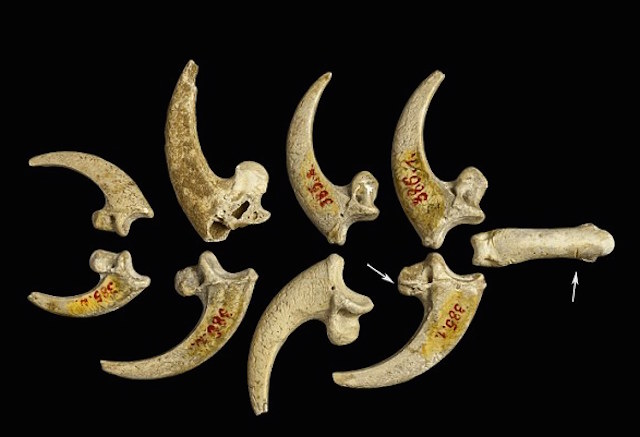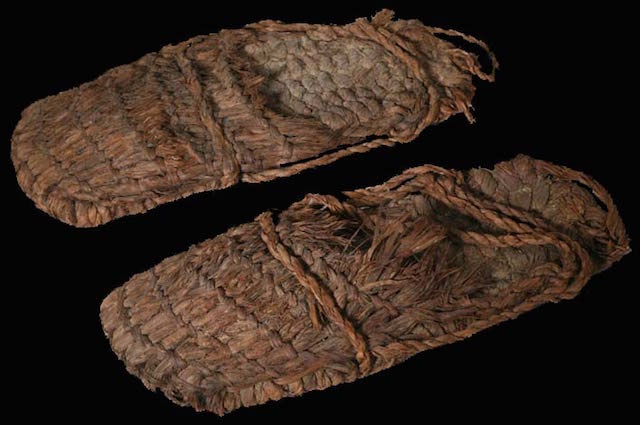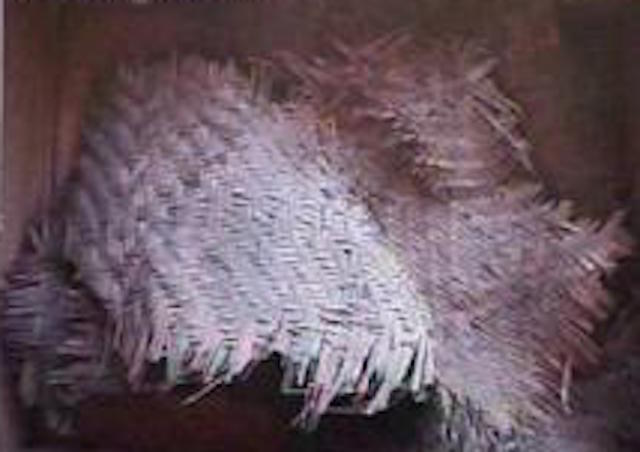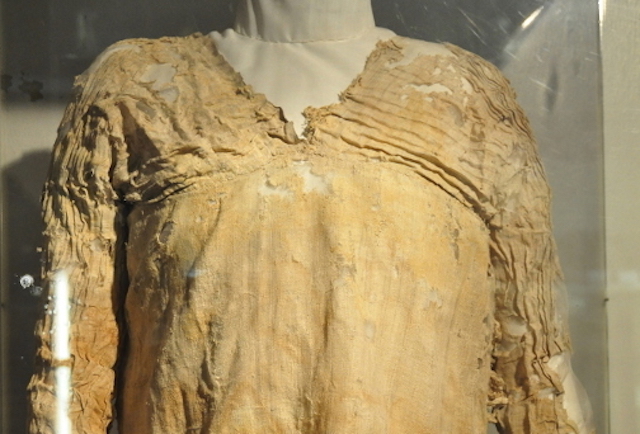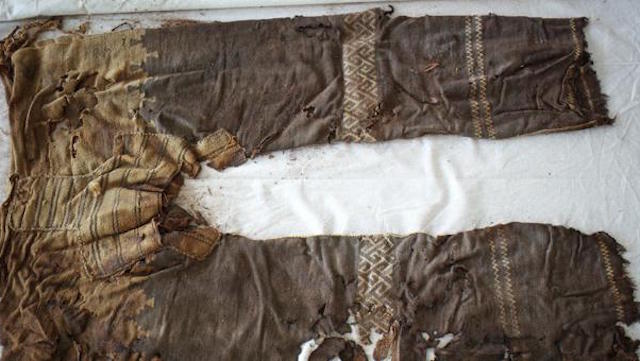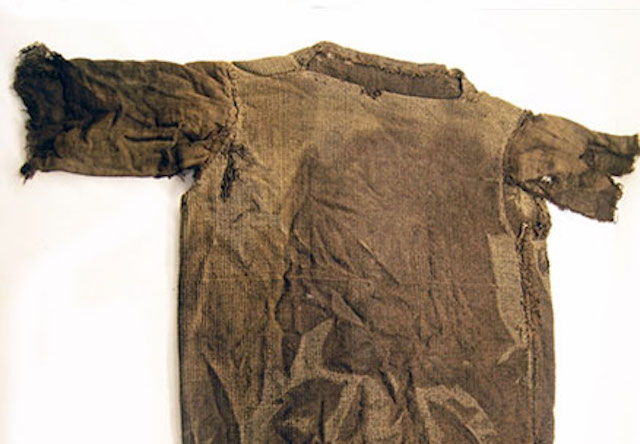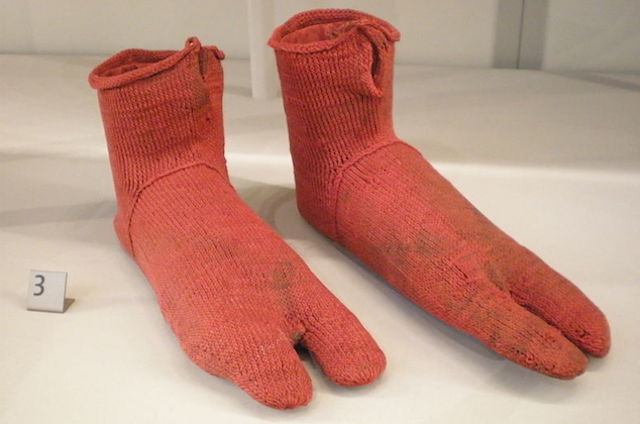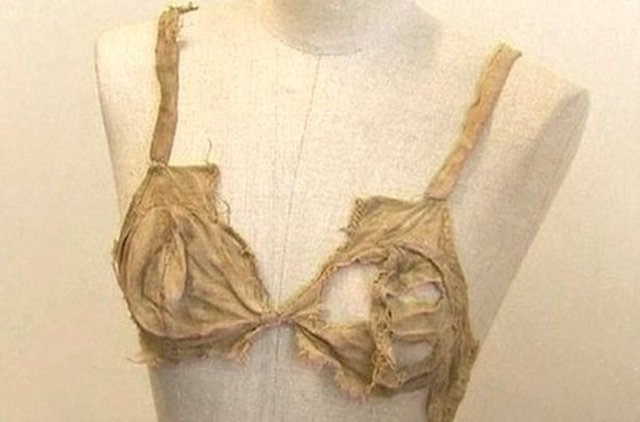Pele's hair are naturally occurring fine fibers of volcanic glass that form when hot molten lava is thrown into the air during explosive eruptions. The strands are formed by the stretching or blowing-out of molten basaltic glass from lava, the same way a glassworker makes thin strands of glass threads by pulling a blob of molten glass. Pele's hair usually form in lava fountains, lava cascades, and vigorous lava flows.
The liquid rock is stretched thinner than a millimeter, some as thin as human hair, and can be as long as 2 meters. Being extremely lightweight, they often get carried away by the wind to places several kilometers away. Fibers of Pele’s hair has been found lodged on high places such as the top of trees, electric poles and radio antennas. They have golden yellow color and looks almost like hair or straw.

This is not a bird’s nest. Its Pele’s Hair. The dark blobs are Pele’s Tears.
The term “Pele’s hair” comes from Hawaiian mythology where Pele is the goddess of fire, lightning, wind and volcanoes, and is said to be the creator of the Hawaiian Islands. Pele’s hair is not limited to Hawaii and can be found near other volcanoes of the world. They are usually found in crevices in the ground or areas where rocks form a corner where the blown Pele's hair can collect.
Touching Pele’s hair with bare hands is not recommended as they are very brittle and very sharp, and small broken pieces can get into the skin of your hand while you are examining it.
Pele’s hairs are sometimes found entangled with the little blobs of hardened volcanic glass called Pele's tears or Achneliths, as geologists like to call them. They are formed the same way Pele’s hair is formed — by the ejection of tiny droplets of lava from a lava fountain. Researchers have found that that the velocity of the erupting lava decides whether Pele’s tears or Pele's hair is formed. If the velocity of the erupting magma is high then Pele’s hair is formed and if the velocity is low the formation of Pele’s tears is favored. Sometimes Pele’s tears are found attached at the tips of Pele’s hairs.
Pele’s tears can tell volcanologists a great deal of information about the eruption. Examination of bubbles of gas and particles trapped within the tears can provide information about the composition of the magma chamber. The shape of the tears can provide an indication of the velocity of the eruption.

Lava fountain draws lava into thin threads which cool to form Pele’s hair.

A sample of Pele's hair from the lava lake within the Halemaʻumaʻu Overlook vent, Hawaii.

Pele’s hair from a Hawaiian volcano.

Strands of Pele’s hair picked up at Hawaii.

Pele's tear with two attached threads of Pele's hair recovered from a pre-1940s eruption of Kilauea Volcano, Hawaii.

Pele’s tears. From left to right, specimens are 9 mm tall, 10.5 mm tall, 9.5 mm tall, and 18 mm tall.

Some odd shaped Pele’s tears recovered from Hawaii.

Pele's hair on a pahoehoe flow at Kīlauea Volcano, Hawaiʻi, March 27, 1984.

Pele's hair caught on a radio antenna mounted on the south rim of Puʻu ʻŌʻō, Hawaiʻi,
Source
READ MORE»
The liquid rock is stretched thinner than a millimeter, some as thin as human hair, and can be as long as 2 meters. Being extremely lightweight, they often get carried away by the wind to places several kilometers away. Fibers of Pele’s hair has been found lodged on high places such as the top of trees, electric poles and radio antennas. They have golden yellow color and looks almost like hair or straw.

This is not a bird’s nest. Its Pele’s Hair. The dark blobs are Pele’s Tears.
The term “Pele’s hair” comes from Hawaiian mythology where Pele is the goddess of fire, lightning, wind and volcanoes, and is said to be the creator of the Hawaiian Islands. Pele’s hair is not limited to Hawaii and can be found near other volcanoes of the world. They are usually found in crevices in the ground or areas where rocks form a corner where the blown Pele's hair can collect.
Touching Pele’s hair with bare hands is not recommended as they are very brittle and very sharp, and small broken pieces can get into the skin of your hand while you are examining it.
Pele’s hairs are sometimes found entangled with the little blobs of hardened volcanic glass called Pele's tears or Achneliths, as geologists like to call them. They are formed the same way Pele’s hair is formed — by the ejection of tiny droplets of lava from a lava fountain. Researchers have found that that the velocity of the erupting lava decides whether Pele’s tears or Pele's hair is formed. If the velocity of the erupting magma is high then Pele’s hair is formed and if the velocity is low the formation of Pele’s tears is favored. Sometimes Pele’s tears are found attached at the tips of Pele’s hairs.
Pele’s tears can tell volcanologists a great deal of information about the eruption. Examination of bubbles of gas and particles trapped within the tears can provide information about the composition of the magma chamber. The shape of the tears can provide an indication of the velocity of the eruption.

Lava fountain draws lava into thin threads which cool to form Pele’s hair.

A sample of Pele's hair from the lava lake within the Halemaʻumaʻu Overlook vent, Hawaii.

Pele’s hair from a Hawaiian volcano.

Strands of Pele’s hair picked up at Hawaii.

Pele's tear with two attached threads of Pele's hair recovered from a pre-1940s eruption of Kilauea Volcano, Hawaii.

Pele’s tears. From left to right, specimens are 9 mm tall, 10.5 mm tall, 9.5 mm tall, and 18 mm tall.

Some odd shaped Pele’s tears recovered from Hawaii.

Pele's hair on a pahoehoe flow at Kīlauea Volcano, Hawaiʻi, March 27, 1984.

Pele's hair caught on a radio antenna mounted on the south rim of Puʻu ʻŌʻō, Hawaiʻi,
Source
























